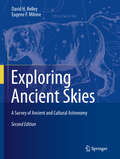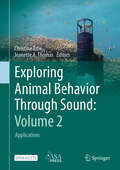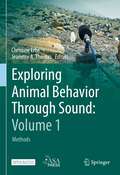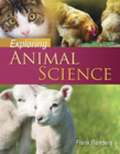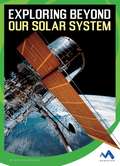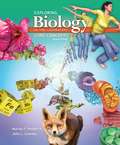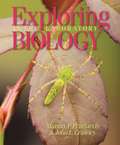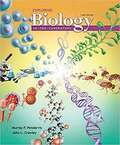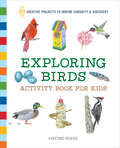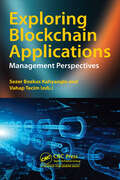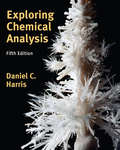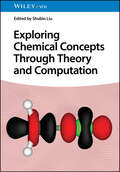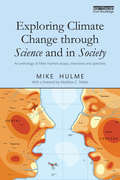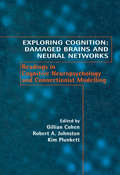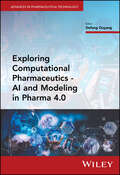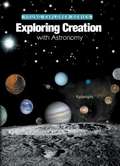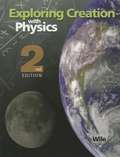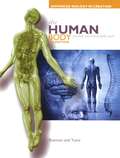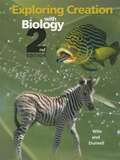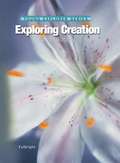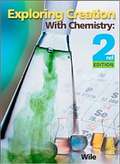- Table View
- List View
Exploring Ancient Skies
by Eugene F. Milone A. F. Aveni David H. KelleyExploring Ancient Skies brings together the methods of archaeology and the insights of modern astronomy to explore the science of astronomy as it was practiced in various cultures prior to the invention of the telescope. The book reviews an enormous and growing body of literature on the cultures of the ancient Mediterranean, the Far East, and the New World (particularly Mesoamerica), putting the ancient astronomical materials into their archaeological and cultural contexts. The authors begin with an overview of the field and proceed to essential aspects of naked-eye astronomy, followed by an examination of specific cultures. The book concludes by taking into account the purposes of ancient astronomy: astrology, navigation, calendar regulation, and (not least) the understanding of our place and role in the universe. Skies are recreated to display critical events as they would have appeared to ancient observers--events such as the supernova of 1054 A.D., the "lion horoscope," and the Star of Bethlehem. Exploring Ancient Skies provides a comprehensive overview of the relationships between astronomy and other areas of human investigation. It will be useful as a reference for scholars and as a text for students in both astronomy and archaeology, and will be of compelling interest to readers who seek a broad understanding of our collective intellectual history.
Exploring Animal Behavior Through Sound: Applications
by Jeanette A. Thomas Christine ErbeThis open-access book offers a profound exploration of the acoustic world of animals. Organized into nine chapters by taxonomy—invertebrates, insects, amphibians, reptiles, fishes, birds, and mammals (subterranean, terrestrial, and marine)—it delves into sound production, sound reception, sound function, and the impacts of noise on these creatures. As the second volume of Exploring Animal Behavior Through Sound, it builds upon the bioacoustic concepts and methodologies established in the first volume. By attuning ourselves to the sounds of nature, we can gain valuable insights into animal behavior, distribution, and demographics, as well as their habitat characteristics and needs, and the effects of noise on their behavior. This book will serve as a valuable resource for students and researchers in animal ecology seeking to incorporate acoustics into their research toolkit, as well as for environmental managers in industry and government.
Exploring Animal Behavior Through Sound: Methods
by Jeanette A. Thomas Christine ErbeThis open-access book empowers its readers to explore the acoustic world of animals. By listening to the sounds of nature, we can study animal behavior, distribution, and demographics; their habitat characteristics and needs; and the effects of noise. Sound recording is an efficient and affordable tool, independent of daylight and weather; and recorders may be left in place for many months at a time, continuously collecting data on animals and their environment. This book builds the skills and knowledge necessary to collect and interpret acoustic data from terrestrial and marine environments. Beginning with a history of sound recording, the chapters provide an overview of off-the-shelf recording equipment and analysis tools (including automated signal detectors and statistical methods); audiometric methods; acoustic terminology, quantities, and units; sound propagation in air and under water; soundscapes of terrestrial and marine habitats; animal acoustic and vibrational communication; echolocation; and the effects of noise. This book will be useful to students and researchers of animal ecology who wish to add acoustics to their toolbox, as well as to environmental managers in industry and government.
Exploring Animal Science
by Frank B. FlandersEXPLORING ANIMAL SCIENCE offers educators the perfect tool for teaching animal agriculture: one that balances the academic background critical to building a strong foundation in fundamental science with the practical, production-oriented content vital to work in the real world. Its coverage spans a variety of areas like nutrition, anatomy and physiology, biotechnology, biosecurity, and genetics and animal reproduction. Each topic is presented in a straightforward manner that first investigates the basics, and then delves further into its practical application to the production, care, and management of animal agriculture. Ideal for a range of students, from late middle school to early high school, this unique approach is sure to engage by drawing such powerful connections between academics and real-life animal-based scenarios and situations. It also includes a wide range of activities that will fit any animal science classroom, making it an appealing choice for teachers and students alike.
Exploring Beyond Our Solar System (Wonders of Space)
by Patricia HutchisonCompelling narrative nonfiction text presents the story of the scientists who are exploring beyond our solar system, featuring the intrigue and excitement behind their missions. Additional features to aid comprehension include a table of contents, fact-filled captions and callouts, infographics, a glossary, a listing of source notes, sources for further research, and an introduction to the author.
Exploring Biological Anthropology: The Essentials
by Craig Britton Stanford John Scott Allen Susan C. AntónExploring Biological Anthropology: The Essentials combines concise coverage of the foundations of the field with modern innovations and discoveries, helping students understand, and get excited about, the discipline. Because the authors conduct research in three of the main areas of biological anthropology–the human fossil record (Susan Antón), primate behavior and ecology (Craig Stanford), and human biology and the brain (John Allen)–they offer a specialist approach that engages students and gives them everything they need to master the subject. The Fourth Edition continues to present traditional physical anthropology within a modern Darwinian framework, and includes coverage of contemporary discoveries to highlight the ever-increasing body of knowledge in biological anthropology.
Exploring Biology In The Laboratory: Core Concepts
by Murray P. Pendarvis John L. CrawleyExploring Biology in the Laboratory: Core Concepts is a comprehensive manual appropriate for introductory biology lab courses. This edition is designed for courses populated by nonmajors or for majors courses where abbreviated coverage is desired. Based on the two-semester version of Exploring Biology in the Laboratory, 3e, this Core Concepts edition features a streamlined set of clearly written activities with abbreviated coverage of the biodiversity of life. These exercises emphasize the unity of all living things and the evolutionary forces that have resulted in, and continue to act on, the diversity that we see around us today.
Exploring Biology in the Laboratory
by Murray Paton Pendarvis John L. CrawleyExploring Biology in the Laboratory is a comprehensive manual appropriate for one- or two-semester introductory general biology lab courses. Clearly-written and engaging activities emphasize the unity of all living things and the evolutionary forces that have resulted in, and continue to act on, the diversity that we see all around us.
Exploring Biology in the Laboratory
by Murray P. Pendarvis John L. CrawleyThis full-color, comprehensive, affordable introductory biology manual is appropriate for both majors and nonmajors laboratory courses. All general biology topics are covered extensively, and the manual is designed to be used with a minimum of outside reference material. The activities emphasize the unity of all living things and the evolutionary forces that have resulted in, and continue to act on, the diversity that we see around us today. Features: An extensive full-color art and photography program includes many specimen and dissection images, labeled diagrams, cladograms, and helpful life-cycle illustrations. In addition to providing the necessary images to help students work through the lab procedures, the manual also includes hundreds of images of representative organisms, providing ample visual support for the lab. Check Your Understanding questions after each exercise ask thought-provoking questions in order to measure student progress throughout the chapter. A Chapter Review ends each chapter and provides thoughtful questions to ensure that students understand the overall concepts from the chapter.
Exploring Biology: An Inquiry Approach
by William R. Bowen Frank A. Romano III Benjamin G. Blair Stacy BlairExploring Biology: An Inquiry Approach Jacksonville State edition
Exploring Birds Activity Book for Kids: 50 Creative Projects to Inspire Curiosity & Discovery
by Kristine RiversExplore the world of birds with hands-on activities for kids ages 8 to 12 Get kids excited about all the beautiful birds that live around them! This bird book for kids is full of fun and games to help young explorers discover the amazing diversity of birds and how important they are to our ecosystem. Inside, they'll discover a wide range of fun things to try, like sketching birds, creating a map of different bird sounds, using binoculars, and more! Go beyond other nature books for kids: Birding basics—This book features simple guidance for going birding, from packing the right tools to observing and recording what they see. Anytime, anywhere—Find tips for successful birdwatching anywhere, whether it's a rural area or a big city. Spark their sense of discovery—Show kids how to respectfully engage with birds in their own habitat and how much birds can teach us. Give curious kids the tools to set off on their own birding adventures with this ultimate bird book for kids.
Exploring Blockchain Applications: Management Perspectives
by Vahap Tecim Sezer Bozkus KahyaogluIn this book, the development process of blockchain algorithms and examples of their applications in different sectors are explored. The opportunities and challenges of blockchain implementations that arise in making technological innovations usable in corporate structures are discussed. In this respect, the book aims to deal with both the conceptual framework and the real challenges and opportunities encountered in practice regarding the blockchain applications. It is tried to contribute to the literature by presenting practical blockchain application suggestions to the readers on a scientific basis.It is a fact that blockchain technology is considered one of the most disruptive and revolutionary innovations after the invention of the internet. Blockchain technology, which was first used for cross-border payments, is coming up with a new application area in a different sector every day. The main purpose of Blockchain-based systems is to spread the "trust" service provided by a central intermediary to machines in transactions between two parties. Thus, it removes the need for this trust from the monopoly of a single intermediary. Blockchain implementation scenarios are to establish math-based trust in an untrusted environment.While exploring the complexity of blockchain applications in different sectors, the emerging risks are also examined from a management perspective. In particular, it is aimed to be a key work that the management levels of the enterprises can benefit from in the decision-making processes.It will be seen that blockchain technologies will be used unlimitedly in design, planning, management and decision making. This book will also introduce new visions for practitioners to use different blockchain technologies and methodologies to face problems.
Exploring Chemical Analysis: International Edition
by Daniel C. HarrisCombining coverage of all major analytical topics with effective problem-solving methods, Exploring Chemical Analysis provides an ideal introduction to analytical chemistry.
Exploring Chemical Concepts Through Theory and Computation
by Shubin LiuExploring Chemical Concepts Through Theory and Computation Deep, theoretical resource on the essence of chemistry, explaining a variety of important concepts including redox states and bond types Exploring Chemical Concepts Through Theory and Computation provides a comprehensive account of how the three widely used theoretical frameworks of valence bond theory, molecular orbital theory, and density functional theory, along with a variety of important chemical concepts, can between them describe and efficiently and reliably predict key chemical parameters and phenomena. By comparing the three main theoretical frameworks, readers will become competent in choosing the right modeling approach for their task. The authors go beyond a simple comparison of existing algorithms to show how data-driven theories can explain why chemical compounds behave the way they do, thus promoting a deeper understanding of the essence of chemistry. The text is contributed to by top theoretical and computational chemists who have turned computational chemistry into today’s data-driven and application-oriented science. Exploring Chemical Concepts Through Theory and Computation discusses topics including: Orbital-based approaches, density-based approaches, chemical bonding, partial charges, atoms in molecules, oxidation states, aromaticity and antiaromaticity, and acidity and basicityElectronegativity, hardness, softness, HSAB, sigma-hole interactions, charge transport and energy transfer, and homogeneous and heterogeneous catalysisElectrophilicity, nucleophilicity, cooperativity, frustration, homochirality, and energy decompositionChemical concepts in solids, excited states, spectroscopy and machine learning, and catalysis and machine learning, as well as key connections between related concepts Aimed at both novice and experienced computational, theoretical, and physical chemists, Exploring Chemical Concepts Through Theory and Computation is an essential reference to gain a deeper, more advanced holistic understanding of the field of chemistry as a whole.
Exploring Climate Change through Science and in Society: An anthology of Mike Hulme's essays, interviews and speeches
by Mike HulmeMike Hulme has been studying climate change for over thirty years and is today one of the most distinctive and recognisable voices speaking internationally about climate change in the academy, in public and in the media. The argument that he has made powerfully over the last few years is that climate change has to be understood as much as an idea situated in different cultural contexts as it is as a physical phenomenon to be studied through universal scientific practices. Climate change at its core embraces both science and society, both knowledge and culture. Hulme’s numerous academic and popular writings have explored what this perspective means for the different ways climate change is studied, narrated, argued over and acted upon. Exploring Climate Change through Science and in Society gathers together for the first time a collection of his most popular, prominent and controversial articles, essays, speeches, interviews and reviews dating back to the late 1980s. The 50 or so short items are grouped together in seven themes - Science, Researching, Culture, Policy, Communicating, Controversy, Futures - and within each theme are arranged chronologically to reveal changing ideas, evidence and perspectives about climate change. Each themed section is preceded with a brief introduction, drawing out the main issues examined. Three substantive unpublished new essays have been specially written for the book, including one reflecting on the legacy of Climategate. Taken as a collection, these writings reveal the changes in scientific and public understandings of climate change since the late 1980s, as refracted through the mind and expression of one leading academic and public commentator. The collection shows the many different ways in which it is necessary to approach the idea of climate change to interpret and make sense of the divergent and discordant voices proclaiming it in the public sphere.
Exploring Cognition: Readings in Cognitive Neuropsychology and Connectionist Modelling
by Gillian Cohen Robert A. Johnston Kim PlunkettExploring Cognition: Damaged Brains and Neural Networks analyses the contribution made by cognitive neuropsychology and connectionist modelling to theoretical explanations of cognitive processes. Bringing together evidence from both damaged brains and neural networks, this exciting and innovative approach leads to re-evaluation of traditional theories: connectionist models lesioned to mimic the residual function of the damaged brain and rehabilitated to simulate the process of recovery suggest underlying mechanisms and challenge previous interpretations.In this reader key articles by leading international researchers are combined with linking commentaries that provide a context, highlight the conceptual themes and evaluate the evidence. Carefully selected to include hotly debated topics, the papers cover, among others, the controversies surrounding explanations for category specificity in object recognition and for covert recognition of faces and words; the mechanisms underlying the use of regular and irregular past tenses; and the reading of regularly and irregularly spelled words. The challenges posed by connectionist models to assumptions about the nature of dissociations, the need for symbolic rule-based operations in language processing and the modularity and localisation of processes are assessed.Exploring Cognition: Damaged Brains and Neural Networks will be of interest to advanced undergraduates, postgraduates and researchers in cognitive neuropsychology and cognitive neuroscience.
Exploring Computational Pharmaceutics: AI and Modeling in Pharma 4.0 (Advances in Pharmaceutical Technology)
by Defang OuyangProvides an extensive and up-to-date overview of the theory and application of computational pharmaceutics in the drug development process Exploring Computational Pharmaceutics - AI and Modeling in Pharma 4.0 introduces a variety of current and emerging computational techniques for pharmaceutical research. Bringing together experts from academia, industry, and regulatory agencies, this edited volume also explores the current state, key challenges, and future outlook of computational pharmaceutics while encouraging development across all sectors of the field. Throughout the text, the authors discuss a wide range of essential topics, from molecular modeling and process simulation to intelligent manufacturing and quantitative pharmacology. Building upon Exploring Computational Pharmaceutics - AI and Modeling in Pharma 4.0, this new edition provides a multi-scale perspective that reveals the physical, chemical, mathematical, and data-driven details of pre-formulation, formulation, process, and clinical studies, in addition to in vivo prediction in the human body and precision medicine in clinical settings. Detailed chapters address both conventional dosage forms and the application of computational technologies in advanced pharmaceutical research, such as dendrimer-based delivery systems, liposome and lipid membrane research, and inorganic nanoparticles. A major contribution to the development and promotion of computational pharmaceutics, this important resource: Discusses the development track, achievements, and prospects of computational pharmaceutics Presents multidisciplinary research to help physicists, chemists, mathematicians, and computer scientists locate problems in the field of drug delivery Covers a wide range of technologies, including complex formulations for water-insoluble drugs, protein/peptide formulations, nanomedicine, and gene delivery systems Focuses on the application of cutting-edge computational technologies and intelligent manufacturing of emerging pharmaceutical technologies Includes a systematic overview of computational pharmaceutics and Pharma 4.0 to assist non-specialist readers Covering introductory, advanced, and specialist topics, Exploring Computational Pharmaceutics - AI and Modeling in Pharma 4.0 is an invaluable resource for computational chemists, computational analysts, pharmaceutical chemists, process engineers, process managers, and pharmacologists, as well as computer scientists, medicinal chemists, clinical pharmacists, material scientists, and nanotechnology specialists working in the field.
Exploring Creation With Astronomy
by Jeannie K. FulbrightThis book covers the major structures of our solar system, starting with the sun and working towards Pluto.science enchanting and memorable for students.
Exploring Creation With Physics
by Jay WileThis college-prep physics course is designed for the student who has completed algebra and has had an introduction to the definitions of sine, cosine, and tangent. It provides a detailed introduction to the methods and concepts of general physics. Heavily emphasizing vector analysis, this text is ideal preparation for a university-level physics course. It provides the student with a strong background in one-dimensional and two-dimensional motion, Newton s laws and their application, gravity, work and energy, momentum, periodic motion, waves, optics, electrostatics, electrodynamics, electrical circuits, and magnetism. The student text contains all student material, on-your-own questions and solutions, laboratory exercises, and chapter study guides. Color illustrations and diagrams."
Exploring Creation with Advanced Biology: The Human Body
by Marilyn Shannon Rachael YunisThis advanced biology course covers the anatomy and physiology of each of the human body s organ systems, while giving God the glory for His creation. Students taking this course should have successfully completed both biology and chemistry.
Exploring Creation with Astronomy 2nd Edition (Apologia’s Young Explorer Series)
by Jeannie K. FulbrightThis textbook is designed to launch your mind on an educational journey through God's incredible universe. It will bring the cosmos into your home through the exploration of the major structures of our solar system, including the sun, planets, and asteroid belt. It then journeys into the stars and galaxies to explain how marvelous and mighty our Creator is.
Exploring Creation with Biology (2nd edition)
by Jay L. Wile Marilyn F. DurnellAre you ready to be impressed? If not, you'd better get ready. Why? Because in this course, you are going to get a broad overview of God's creation. As you begin to learn its secrets, you will become more and more impressed with its majesty and complexity. The sheer grandeur of it all should leave you in awe of God's mighty power. If you learn nothing else in this course, learn to appreciate the wonder of God's creation! If you are like most students, this will be the first truly rigorous science course that you have ever taken. Thus, you might find it difficult to adjust to the time and patience required by a course like this. If you find yourself getting frustrated or discouraged, remember that whether you decide to go to college, go straight into the workforce, or get married and become a full time parent, there will be many tasks more rigorous than the experience of studying biology. Thus, you need to stick with it, because life is full of challenges!
Exploring Creation with Botany
by Jay L. Wile Jeannie FulbrightThe book is written directly to the student, making it appealing to kids. Presenting science concepts in a conversational, engaging style makes science enchanting and memorable for your students. It also fosters a love for learning. This course is written for children between six and twelve years old. When the course is complete, this book will serve as an excellent reference for your family's future questions and studies in botany. As a result, this book is a life-long investment!
Exploring Creation with Chemistry (2nd Edition)
by Jay L. WileWhat is chemistry? That's a very good question. Chemistry is, quite simply, the study of matter. Of course, this definition doesn't do us much good unless we know what matter is.
Exploring Creation with Chemistry (Third Edition)
by Kristy PlourdeExploring Creation with Chemistry, 3rd Edition provides a rigorous foundation in chemistry in order to prepare your student for college-level studies. We recommend that students taking this course be proficient at an algebra math level. Topics include significant figures, units, classification, the mole concept, stoichiometry, thermochemistry, thermodynamics, kinetics, acids and bases, redox reactions, solutions, atomic structure, Lewis structures, molecular geometry, gas laws, and equilibrium. The textbook offers in-depth discussions and explanations of concepts, as well as biographical sketches of Christian scientists who ve made a difference in the field while giving the glory to God. Experiments include measuring specific heat, discovering the electrical conductivity of compounds dissolved in water, measuring the width of a molecule, exploring freezing point depression, using the ideal gas equation, recognizing the effects of catalysts, and much more.
